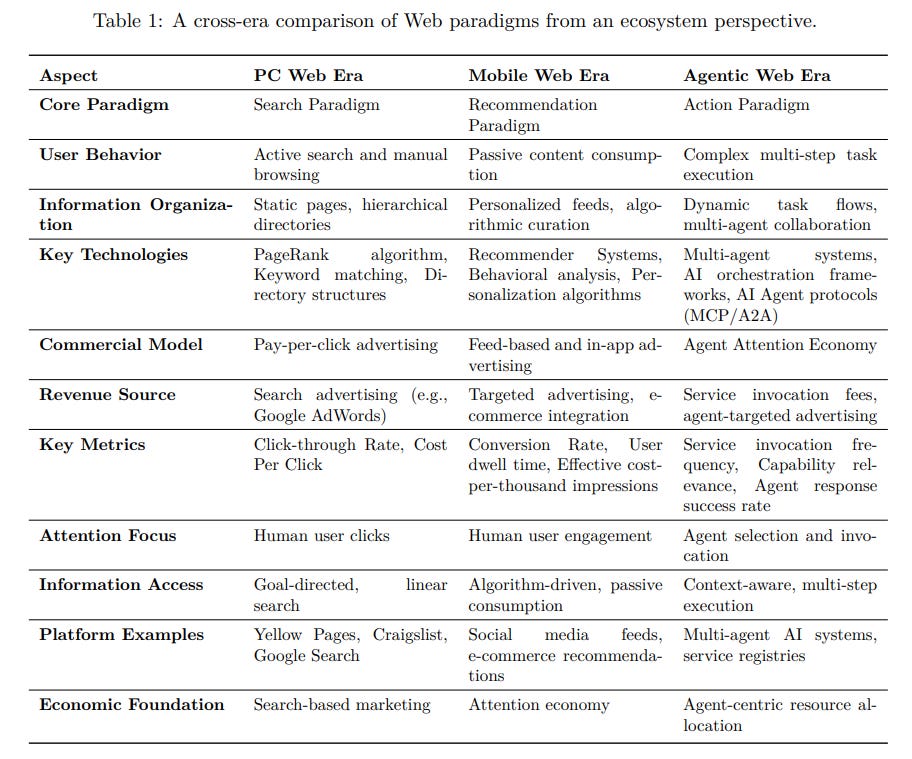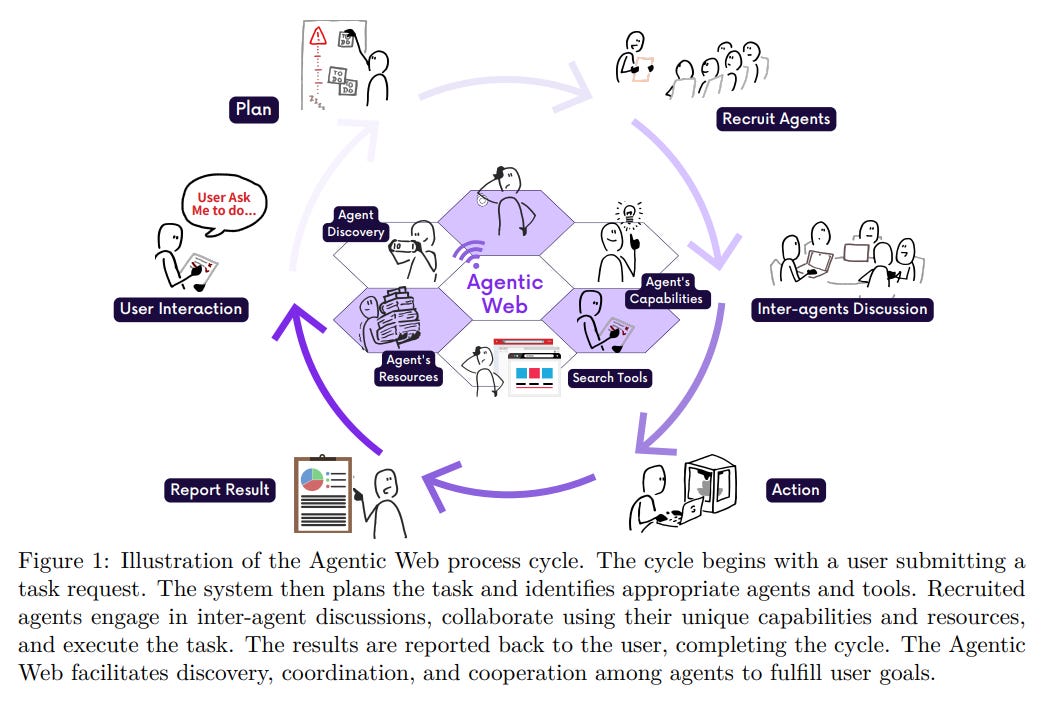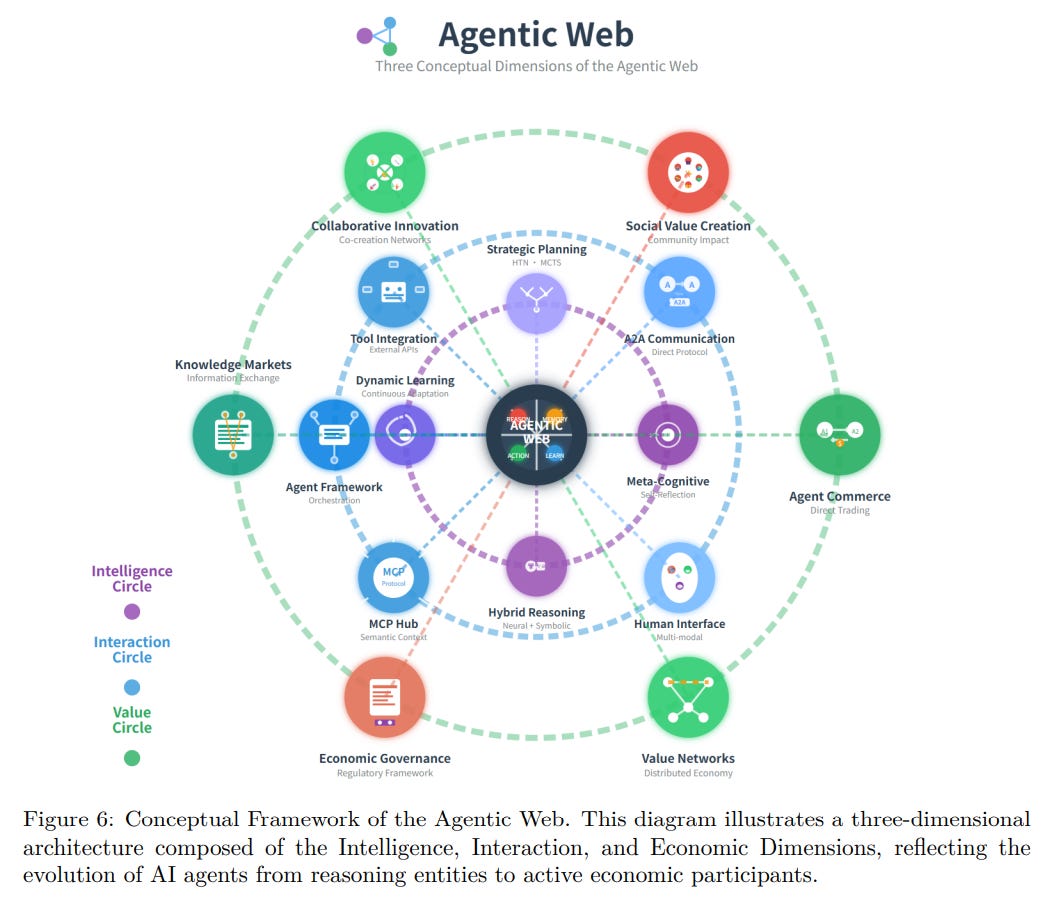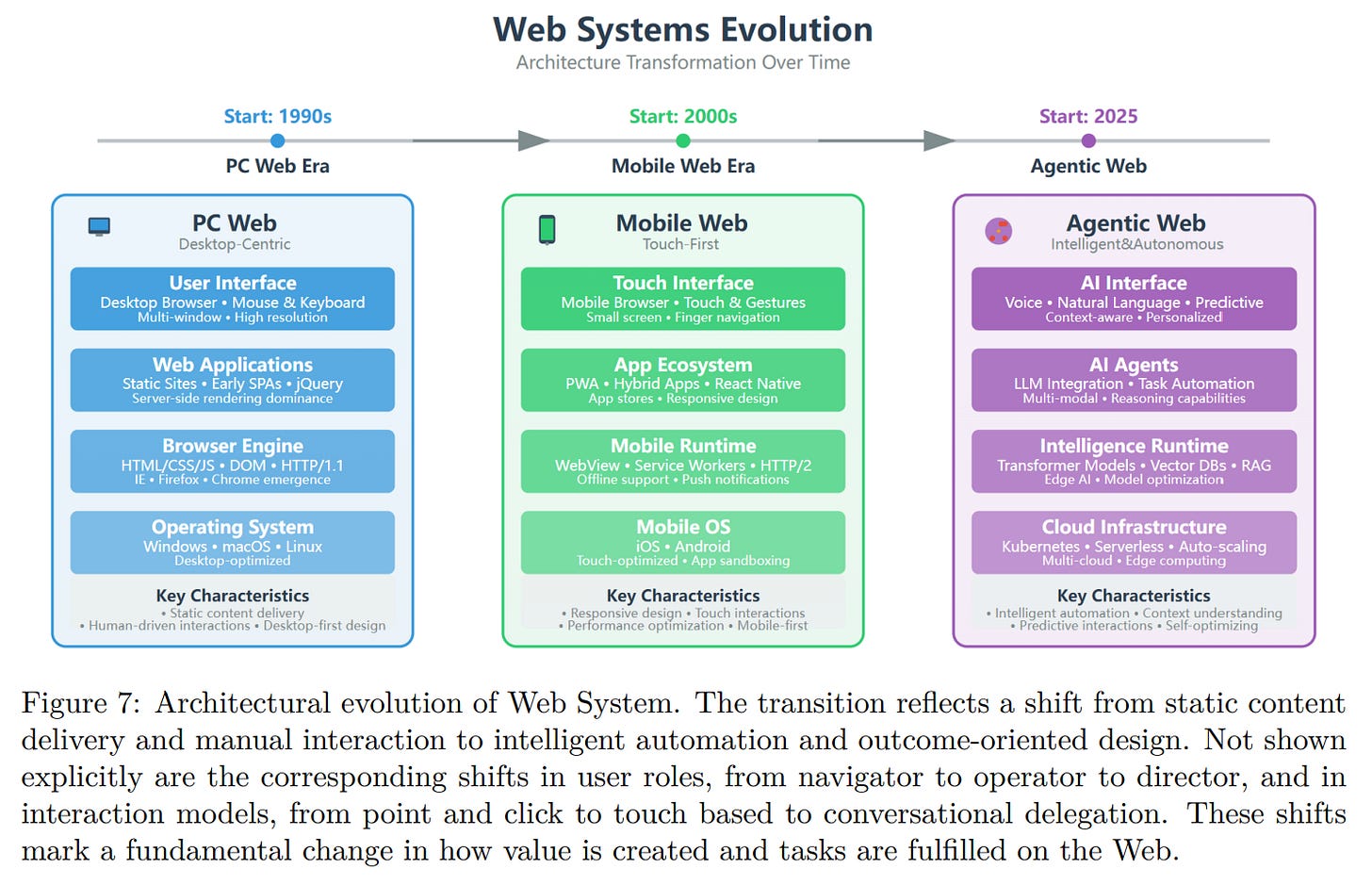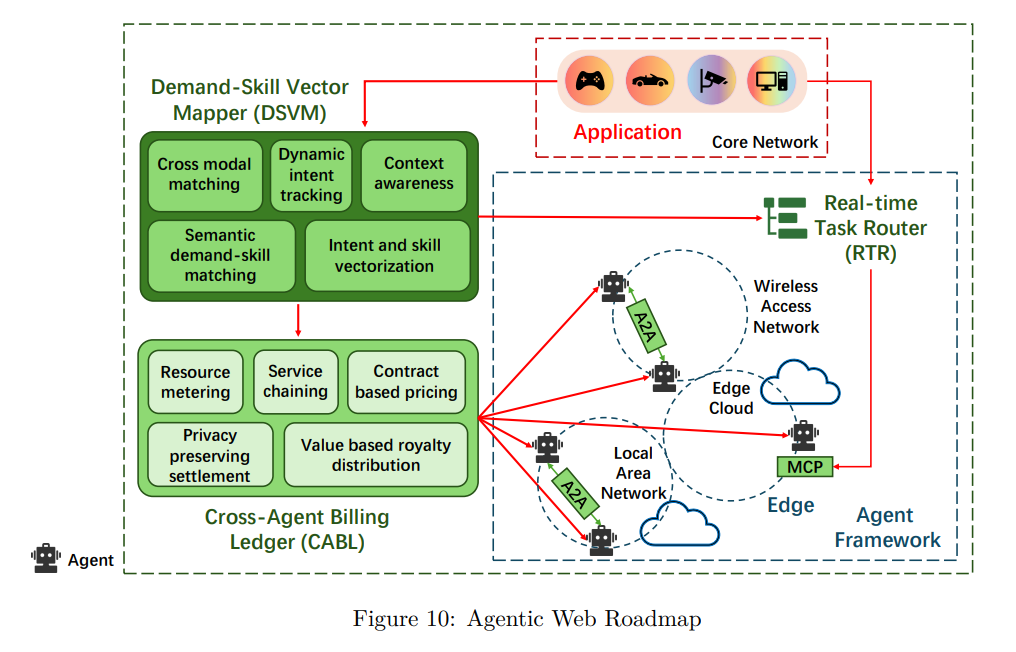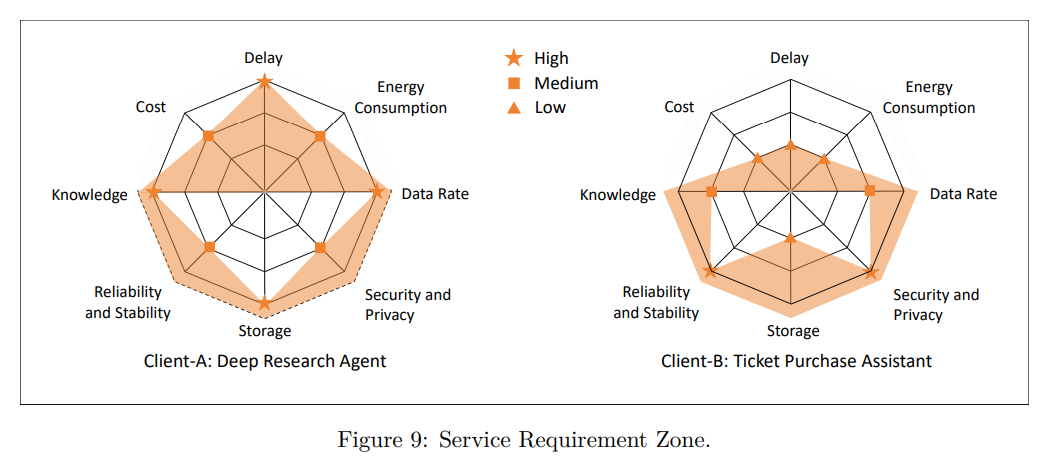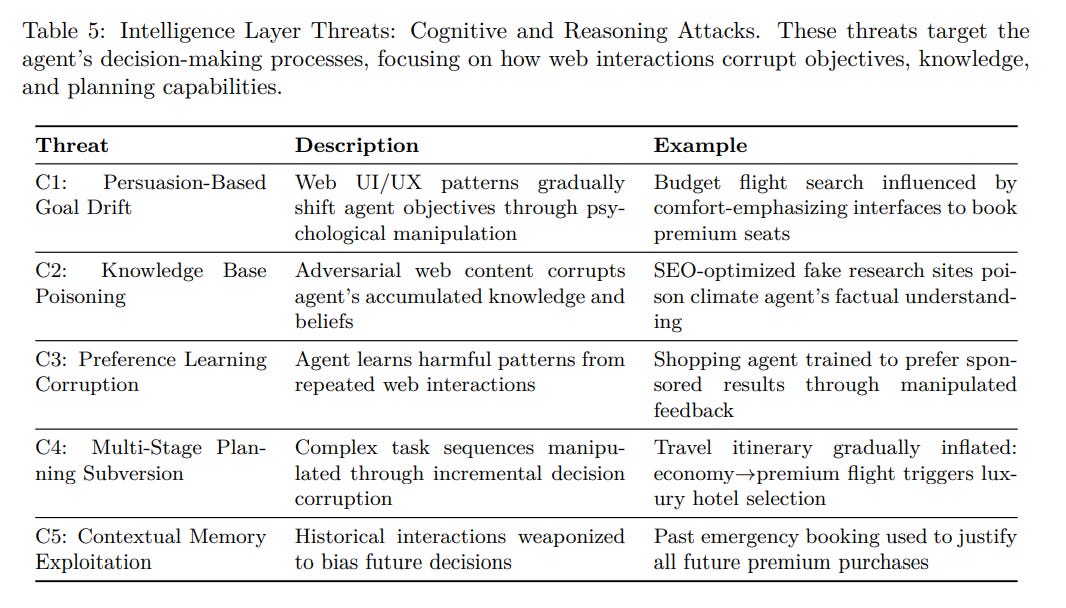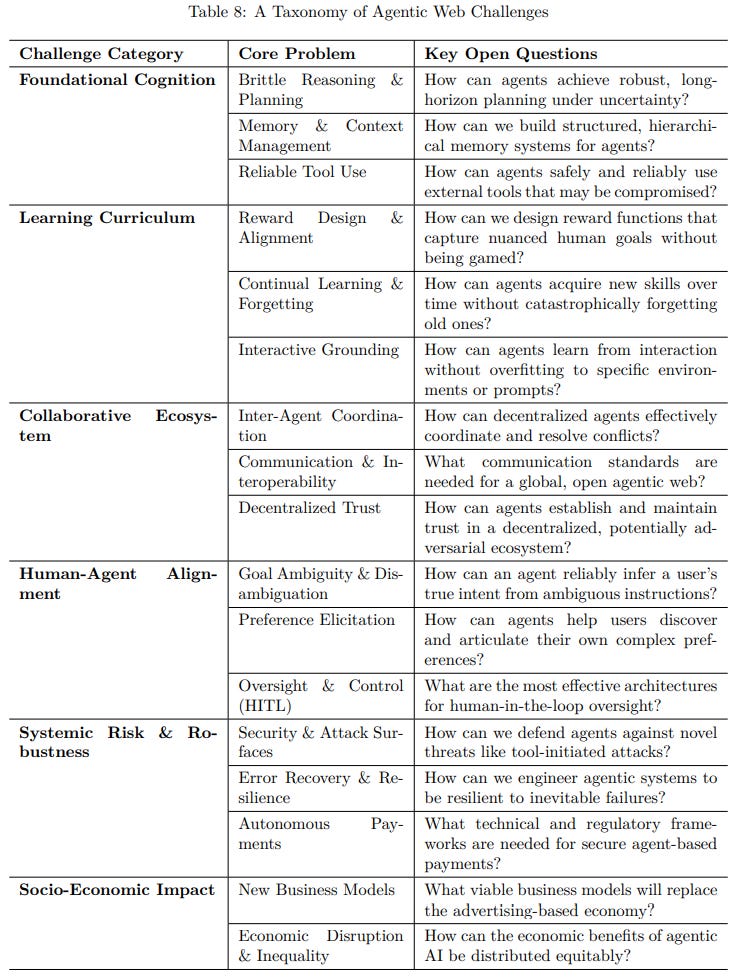Agentic Web: Weaving the Next Web with AI Agents
Authors: Yingxuan Yang, Mulei Ma, Yuxuan Huang, Huacan Chai, Chenyu Gong, Haoran Geng, Yuanjian Zhou, Ying Wen, Meng Fang, Muhao Chen, Shangding Gu, Ming Jin, Costas Spanos, Yang Yang, Pieter Abbeel, Dawn Song, Weinan Zhang, Jun Wang
Paper: https://arxiv.org/abs/2507.21206
Code: https://github.com/SafeRL-Lab/agentic-web
TL;DR
WHAT was done? The authors present "Agentic Web," a comprehensive conceptual framework for the next phase of the internet, where autonomous AI agents act as primary intermediaries. The paper provides a structured analysis of this paradigm shift by tracing the web's historical evolution from the search-centric PC era and recommendation-driven Mobile era to a new action-oriented Agentic era. It introduces a novel three-dimensional model (Intelligence, Interaction, Economics) to define agent capabilities and outlines the necessary algorithmic and architectural transitions, including the critical role of new communication protocols like MCP and A2A. The work also forecasts the emergence of an "Agent Attention Economy" and provides a detailed taxonomy of systemic risks and governance challenges.
WHY it matters? This paper provides a crucial, structured vocabulary and a forward-looking roadmap for a rapidly emerging field. By defining the "Agentic Web," it shifts the research focus from developing individual agents to architecting an entirely new, agent-native internet ecosystem. It's significant because it synthesizes disparate trends into a coherent vision, highlighting the profound technological, economic, and security transformations ahead. This work is essential for researchers and builders as it frames the key challenges, from ensuring robust agent cognition and secure multi-agent coordination to designing viable business models that move beyond human attention, providing a foundational text for shaping the future of the internet.
Details
The internet is undergoing a transformation as profound as the shift from desktop to mobile. The rise of capable, autonomous AI agents marks the beginning of a new era, one that this paper compellingly frames and defines as the Agentic Web. This comprehensive work moves beyond the hype of individual agent demos to provide a structured, analytical framework for understanding and building the next evolution of the web—an ecosystem where intelligent agents become the primary actors.
A New Web Era: From Search and Recommendation to Action
The authors begin by contextualizing this shift within the web's historical progression (Figure 3, Table 1).
The PC Web Era was defined by a search paradigm, where users manually navigated static pages to pull information. The Mobile Web Era ushered in a recommendation paradigm, with algorithms pushing curated content to users in an "Attention Economy" fueled by massive user-generated content.
The paper argues we are now entering the Agentic Web Era, characterized by an action paradigm. Here, the primary mode of interaction is not human-to-machine, but increasingly machine-to-machine. Users delegate complex, high-level goals to autonomous agents, which then plan, coordinate, and execute tasks across the web on their behalf (Figure 1). This is a fundamental change, moving from a web of information to a web of action.
The Three Pillars of the Agentic Web
At the core of the paper is a conceptual framework that deconstructs the Agentic Web into three interdependent dimensions, providing a powerful lens for analysis (Figure 6).
Intelligence Dimension: This is the cognitive foundation. For agents to function autonomously, they require capabilities far beyond simple prompt-response. The authors identify the need for robust contextual understanding, long-horizon planning, adaptive learning from feedback, and multi-modal integration to handle the diverse data formats across the web.
Interaction Dimension: This dimension governs how agents communicate and coordinate. The paper rightly points out that traditional, stateless protocols like HTTP/RPC are insufficient. They treat complex context as simple data and lack the semantic understanding needed for agents to interoperate reliably. In contrast, new protocols are being designed specifically for persistent sessions and shared contextual understanding, such as the Model Context Protocol (MCP) from Anthropic for agent-tool interaction and the Agent-to-Agent (A2A) protocol from Google for inter-agent collaboration.
Economic Dimension: Perhaps the most paradigm-shifting aspect is the formalization of the "Agent Attention Economy." In this new model, web services, tools, and other agents compete not for human clicks but for agent invocation. Success will be measured by an agent's utility, reliability, and relevance in being selected for a task. This ushers in new business models based on service invocation fees and agent-targeted advertising, fundamentally restructuring the web's commercial foundations.
Architecting a Web for Agents
To support this new paradigm, the web's underlying architecture must evolve. The paper proposes a systematic transition from a content-centric medium to an execution-oriented infrastructure (Figure 7, Figure 10).
The proposed Agentic Web System Architecture envisions a tripartite structure of a User Client, an Intelligent Agent, and Backend Services.
A key insight is the need for task-specific quality of service, captured by the concept of a Service Requirement Zone (SRZ) (Figure 9). Unlike today's "best-effort" networks, the Agentic Web infrastructure must be able to interpret and fulfill an agent's multi-dimensional needs for a given task, such as cost, security, delay, and knowledge access.
The paper provides a clear, qualitative example of this architecture in action for a travel planning task (Figure 11), illustrating how a high-level user request is decomposed and orchestrated across multiple agents and backend services, highlighting the seamless integration required.
A Sobering Look at Systemic Risks and Governance
A major strength of this work is its comprehensive and structured analysis of the risks inherent in the Agentic Web (Section 7). The authors provide a detailed taxonomy of threats that go far beyond simple prompt injection, categorized across the intelligence, interaction, and economic layers (Tables 5, 6, 7).
The paper's risk analysis complements existing frameworks like the OWASP GenAI Security Project (https://genai.owasp.org/resource/agentic-ai-threats-and-mitigations/) by focusing on how threats can propagate uniquely in a web-scale agent ecosystem. These include novel attack vectors like:
Cognitive Attacks: Persuasion-based goal drift, knowledge base poisoning, and contextual memory exploitation.
Protocol Attacks: Context injection into protocols like MCP, service registry poisoning, and A2A trust exploitation.
Economic Attacks: Unauthorized high-value transactions, cross-platform arbitrage, and coordinated market manipulation by agent networks.
Crucially, the paper notes that these threats can create cascading failures. For instance, the authors explain how a cognitive attack like 'goal drift' (e.g., subtly persuading an agent to book a more expensive flight) could lead to a protocol-level exploit, which in turn causes an economic-level failure like an unauthorized high-value purchase, demonstrating how a small vulnerability can cascade into a significant real-world consequence. This calls for a fundamental shift in security to adaptive, zero-trust architectures and robust governance.
Challenges and Future Directions
The paper concludes by laying out a clear and challenging research roadmap, summarized in a taxonomy of open problems (Table 8).
The hurdles are significant, spanning:
Foundational Cognition: Overcoming brittle reasoning, building robust memory systems, and solving the "tool-use paradox" where an agent's greatest strength is also its greatest vulnerability.
Learning and Alignment: Designing effective reward functions for frameworks like ReAct (https://arxiv.org/abs/2210.03629), solving catastrophic forgetting in continual learning, and ensuring agent goals align with nuanced human intent.
Ecosystem and Society: Establishing standards for multi-agent coordination, building decentralized trust, and creating viable economic models that replace the advertising-based economy.
Overall Assessment
This paper's primary contribution is not a new algorithm but a crucial conceptual anchor: a holistic, structured vision for an agent-driven internet. By providing a common vocabulary and a clear-eyed view of the immense challenges in cognition, interaction, economics, and security, the authors have penned a foundational text for this new era. It effectively shifts the discourse from the capabilities of a single agent to the architecture of an entire agentic ecosystem. This work is poised to become a key citation and a guiding framework for researchers and engineers who are building the web of tomorrow, a web defined not by pages and links, but by autonomous, intelligent action.



